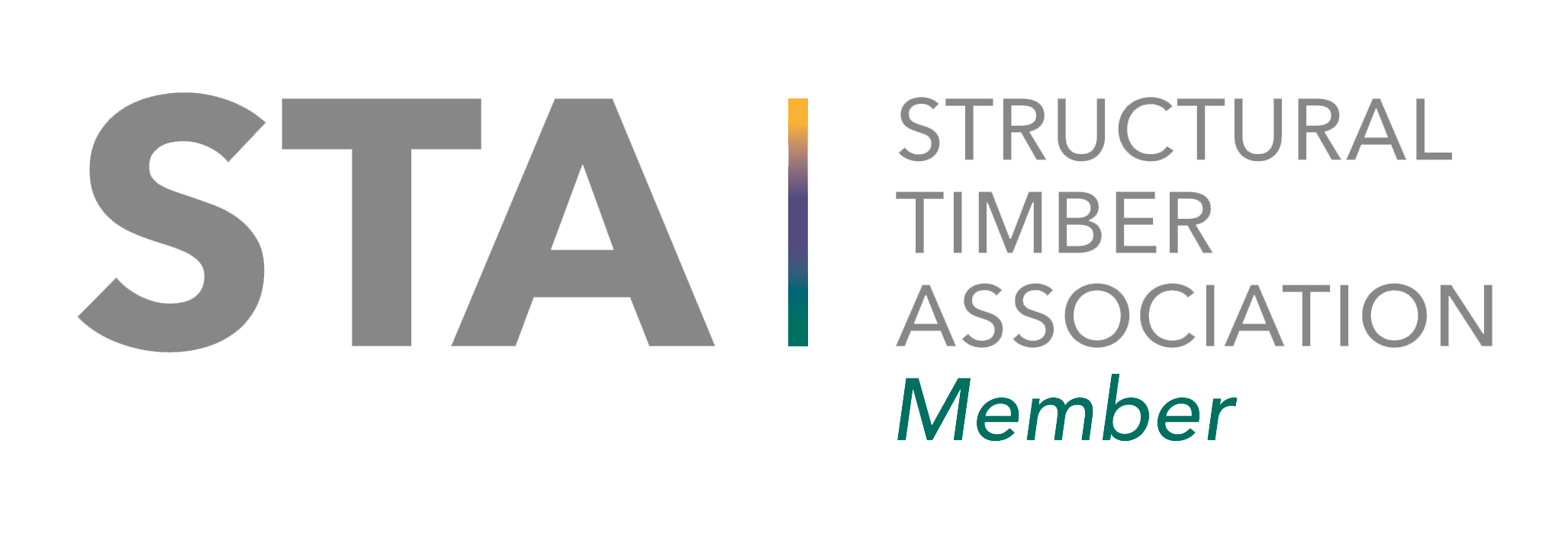To help you throughout your timber frame journey, we have collated common terms used across the industry and provided definitions. This will ensure you fully understand every step of the process, and can progress with confidence.
If there are any terms we've missed, or you have any questions at all, please don't hesitate to get in touch with the Kirkwood Timber Frame team.
A · B · C · D · E · F · G · I · L · O · P · R · S · T · V · W
Acoustic insulation is a type of soundproofing that attempts to prevent sound from entering or exiting an enclosed space by creating a barrier between the interior and the exterior area. It is usually made from finely spun fibers of glass, rock or cotton, which are woven together to form a dense layer measuring a few inches thick, and is supplied in.
Also known as gable roof panels, these are the panels that close off the external wall in the loft area and will usually follow the shape of the roof.
Similar to the above, these are the panels that separate loft spaces between semi-detached or terraced properties.
The decorative piece of trim located under the window sill on the interior of the structure, usually made from the same materials as the skirtings and facings.
a person who designs buildings and in many cases also supervises the construction/build
Although the term design has a broad meaning, it usually refers to the combination of the creative and technical part, setting the basis of a project or an idea. Therefore, architectural design is considered the basis and the first phase before bringing the idea to reality.
A moulding surround most commonly seen around door frames, but also seen around window frames.
a bar is installed on a window to give them the traditional appearance of individual window panes.They can either be fixed onto the window or between the panes.
Also known as room in roof trusses, these are the ideal solution to providing additional living areas within the roof space.
Also known as a skirting block, this is simply a piece of MDF or wood which is slightly thicker and wider than your skirting board and architrave (facing). It sits at the bottom of the architrave and located at either side of the door.
A breather membrane is a sheet of material that is installed to the outer side of insulation on both roofs and walls. It allows water vapour to pass through from the inside of the roof or walls, without requiring any ventilation to be installed directly above the insulation layer.
Documentation that proves that the building work which has been carried out meets building regulations.
a set of standards for the design and construction of buildings to ensure the safety and health for people
The legal permission which is required prior to starting building work.
A casement style window features a design that opens with hinges at the side of the window frame. Being hinged at the side, or top or bottom in some cases, gives the window the ability to open at the middle.Casement windows are usually opened outwards.
Kiln dried timber, strength graded for use in timber frame panels.
A sloping ceiling that spans between a vertical wall and a flat ceiling, found in an attic room.
These are wooden strips that are installed vertically over pitched roofs to which horizontal tiling battens are attached. They are used to allow rainwater to pass off the tiles and away from your roof.
Custom build homes are self build homes facilitated in some way by a developer. This offers the chance to have a unique home that suits your needs, lifestyle and design preferences, through a more hands off approach than a traditional self build.
A DPC is a physical barrier that prevents water from moving up a wall. The plastic DPC is installed into the wall in the construction phase, the plastic membrane then acts as a barrier. This prevents water from passing through it.
A type of membrane material that is used to prevent moisture transition and is typically laid under a concrete slab.
A dormer is a roofed structure, often containing a window, that projects vertically beyond the plane of a pitched roof. They come in different sizes and styles and can have different roof finishes i.e. gable or hip.
Refer to dormer haffits.
also known as dormer cheeks. These are the triangle shaped walls that form the sides of the dormers
EPCs tell you how energy efficient a building is and give it a rating from A (very efficient) to G (very inefficient). They’ll tell you how costly it will be to heat and light your property, and what its carbon dioxide emissions are likely to be.
Commonly refers to the windows and external doors.
A fascia, sometimes referred to as a fascia board, is a horizontal band which runs along the lower edge of a roof where it overhangs the building’s outer walls, helping close the gap between the roof and the wall.
(Also referred to as stage 3) This includes skirting boards, door architraves, internal door sets and stair balustrade.
A factory-manufactured panel comprising a series of floor joists or rafters joined together with trimmers or end-joists to form a load-bearing element of floor or roof construction. Generally used for residential or low to medium-rise buildings timber.
A ladder frame that forms the overhang of the roof at the gable ends and that ties back to the last truss, while providing lateral stability to the gable panel below.
Work done to prepare sub-surfaces for the start of construction work. Aside from any demolition or site enabling works that may need to be carried out, groundworks are usually the first stage of a construction project and may include ground investigation, site clearance etc.
An engineered floor joist formed in the shape of the letter ‘I’, used mainly in mid-floor construction. It has a solid timber (sometimes LVL) top and bottom flange, joined together by a web of sheet material. A lightweight alternative to solid timber joists.
A lintel is usually a timber beam positioned above a window or door opening to support the timber structure above. Can be steel or concrete when used as a beam over an opening in the external wall i.e. brick or blockwork.
Refer to soleplate.
A type of engineered wood panel made using waterproof heat-cured adhesives and rectangularly shaped wood strands that are arranged in cross-orientated layers. This is commonly used as sheathing in timber frame walls and decking for timber floors.
Not to be confused with a wall that sits directly on the boundary of land belonging to two or multiple different owners. A party wall in timber frame refers to the walls that separate living spaces between semi-detached or terraced properties.
Polyisocyanurate is a rigid thermal insulation board.
Planning permission refers to consent from your local authority for a proposed building, which is in place to deter inappropriate developments. It's usually required when building a new dwelling or making extensive changes to an existing one.
Lengths of timber fitted longitudinally and diagonally to support the roof trusses during roof construction.
(Also referred to as stage 2) This includes insulation, VCL, service battens, plasterboard, chipboard, timber battens, etc.
a professional who ensures that any building is compliant with the latest SAP guidelines and procedures
timber or sheet material fitted on top of the roof rafters, adds strength to the roof structure and is particularly used in locations of extreme weather conditions.
Self-build projects are defined as those where someone directly organises the design and construction of their own home. This covers a wide range of projects from a traditional DIY self-build home to projects where the self-builder employs someone to build their home for them.
an expert who can give you valuable advice regarding self build mortgages while helping to guide you through the process
a loan which is taken out to fund a property which you are building yourself. The main difference from a standard residential mortgage is that you receive the funds in stages as parts of the build are finished, rather than as a single lump sum.
most commonly it refers to the underside of the eaves, that is, the underside of the part of the roof that projects beyond the external wall of a building.
Lengths of timber, the same width as the timber frame panels, laid horizontally and bolted to the foundation. Often referred to as locating plate, as its purpose is to set out the location of the external and load bearing walls in preparation for the timber frame panels.
Set of government guidelines for calculating the energy performance of a building.
SER has been appointed by the Scottish Government's Building Standards Division (BSD) to administer a scheme for Certification of Design (Building Structures). The certifying engineer is responsible for ensuring that all aspects of design of the structure of a project satisfy the requirements of the Building (Scotland) Regulations 2004. The legislation also makes engineers who are responsible for building structures specifically aware of their responsibilities and duties in the design, thus improving assurance of structural safety.
Studs form walls and may carry vertical structural loads or be non load-bearing, such as in partition walls, which only separate spaces. They will usually be spaced at 600crs but may be at 400 or 300crs if needed.
The substructure is the lower part of a building which is constructed below the ground level.
The superstructure is the portion of a building which is constructed above the ground level and it serves the purpose of structure’s intended use. In timber frame this would represent the the timber walls, floor and roof elements.
the process where bids are collected by contractors to carry out specific packages of construction work
Lengths of timber fitted to the roof horizontally, on top of counter battens, in preparation for fixing roof tiles.
an accurate representation of the area of a site, property or area of land which is scaled and detailed to demonstrated all natural manmade features
A triangulated structure, manufactured using timber and metal plates, usually positioned at 600mm centres to form a roof.
a project which is designed, developed and equipped with all facilities by a company under a contract which is then handed over to a buyer when it becomes ready to operate business
A polythene barrier designed to prevent moisture from within a property contacting with insulation, reducing the risk of condensation.
A timber frame building is considered to be wind and watertight once the timber frame walls and roof structure are erected, windows are installed and roof sarking and membrane are fitted.




